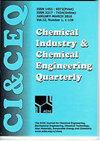Energy analysis of the convective drying of iron ore fines
IF 0.8
4区 工程技术
Q4 CHEMISTRY, APPLIED
Chemical Industry & Chemical Engineering Quarterly
Pub Date : 2022-01-01
DOI:10.2298/ciceq220208026s
引用次数: 1
Abstract
Drying operations in iron ore processing plants have a particularly high energy demand due to the massive solid flow rates employed in this industry. A 33 full-factorial design was applied to investigate the effects of air temperature, airflow velocity, and solids load on the drying time and the specific energy consumption (SEC) of the convective drying of iron ore fines in a fixed bed. The results demonstrated that each drying air condition was associated with an optimal solids load that minimized the SEC. A load of 73 g (bed height of about 0.8 cm) was identified and validated as the optimal condition in terms of energy consumption for the configuration with the highest air temperature (90?C) and airflow velocity (4.5 m/s). This condition resulted in a drying time of 29.0 s and a corresponding SEC of 12.8 MJ/kg to reduce the solids moisture content from 0.11 to a target of 0.05 kg water/kg dry solids. The approach presented here for identifying the optimum values for the process variables should assist in the design and operation of energy efficient convective dryers for iron ore fines.铁矿细粒对流干燥的能量分析
由于该行业采用了大量的固体流,因此铁矿石加工厂的干燥操作具有特别高的能源需求。采用33全因子设计,研究了空气温度、气流速度和固体载荷对固定床铁矿粉对流干燥时间和比能耗(SEC)的影响。结果表明,每种干燥空气条件都与最大限度地减少SEC的最佳固体负荷相关。在最高空气温度(90°C)和气流速度(4.5 m/s)的配置中,负荷为73 g(床高约0.8 cm)被确定并验证为能耗的最佳条件。在这种条件下,干燥时间为29.0 s,相应的SEC为12.8 MJ/kg,将固体含水量从0.11降低到0.05 kg水/kg干固体的目标。本文提出的确定过程变量的最佳值的方法应有助于设计和操作高效对流干燥机的铁矿粉。
本文章由计算机程序翻译,如有差异,请以英文原文为准。
求助全文
约1分钟内获得全文
求助全文
来源期刊

Chemical Industry & Chemical Engineering Quarterly
CHEMISTRY, APPLIED-ENGINEERING, CHEMICAL
CiteScore
2.10
自引率
0.00%
发文量
24
审稿时长
3.3 months
期刊介绍:
The Journal invites contributions to the following two main areas:
• Applied Chemistry dealing with the application of basic chemical sciences to industry
• Chemical Engineering dealing with the chemical and biochemical conversion of raw materials into different products as well as the design and operation of plants and equipment.
The Journal welcomes contributions focused on:
Chemical and Biochemical Engineering [...]
Process Systems Engineering[...]
Environmental Chemical and Process Engineering[...]
Materials Synthesis and Processing[...]
Food and Bioproducts Processing[...]
Process Technology[...]
 求助内容:
求助内容: 应助结果提醒方式:
应助结果提醒方式:


